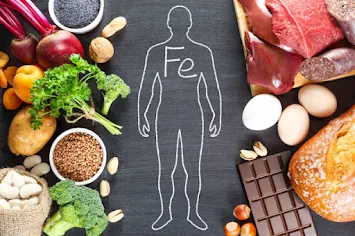Understanding Iron Deficiency Symptoms, Causes, Treatment, and Rich Food Sources
Iron deficiency is a common nutritional deficiency that can lead to anemia and other health issues. It is essential to recognize the symptoms, understand the causes, and know how to address and prevent iron deficiency through treatment and diet.
Symptoms of Iron Deficiency
General Symptoms:
- Fatigue: Persistent tiredness and lack of energy.
- Weakness: General physical weakness and reduced endurance.
- Paleness: Noticeable paleness of the skin and mucous membranes.
- Shortness of Breath: Feeling breathless with minimal exertion.
- Dizziness or Lightheadedness: Especially when standing up quickly.
- Cold Hands and Feet: Poor circulation can lead to feeling cold.
- Headaches: Frequent headaches or migraines.
- Restless Legs Syndrome: An uncomfortable sensation in the legs, especially at night.
Symptoms of Anemia Due to Iron Deficiency
- Irregular Heartbeat: Palpitations or a racing heart.
- Brittle Nails: Nails may become thin and break easily.
- Hair Loss: Increased hair shedding and thinning.
- Sore Tongue or Mouth: A smooth, inflamed, or sore tongue, and mouth ulcers.
Causes of Iron Deficiency
1. Inadequate Dietary Intake: Not consuming enough iron-rich foods.
2. Increased Iron Needs: Conditions like pregnancy, growth spurts in children, or heavy menstruation can increase iron requirements.
3. Poor Absorption: Conditions such as celiac disease or Crohn's disease can impair iron absorption.
4. Chronic Blood Loss: From sources such as gastrointestinal bleeding, heavy menstrual periods, or frequent blood donation.
5. Parasitic Infections: Certain infections can cause iron loss or interfere with absorption.
Treatment for Iron Deficiency
Dietary Changes:
- Iron-Rich Foods: Increase intake of foods high in iron (see below).
- Vitamin C: Enhances iron absorption; consume foods rich in vitamin C (e.g., citrus fruits, bell peppers) with iron-rich meals.
Iron Supplements:
- Ferrous Sulfate: Commonly prescribed and effective for increasing iron levels.
- Other Forms: Ferrous gluconate, ferrous fumarate, or heme iron supplements may be used based on individual tolerance and needs.
Addressing Underlying Conditions:
- Medical Evaluation: Treating any underlying conditions or causes of iron deficiency, such as gastrointestinal issues or menstrual problems.
Rich Food Sources of Iron
Here’s a list of iron-rich foods with their approximate iron content per 100 grams:
Animal-Based Sources (Heme Iron)
- Beef Liver – 6.5 mg of iron per 100 g
- Chicken Liver – 9.0 mg of iron per 100 g
- Lean Beef – 2.7 mg of iron per 100 g
- Turkey (Dark Meat) – 2.3 mg of iron per 100 g
- Pork – 1.0 mg of iron per 100 g
- Fish (Tuna) – 1.4 mg of iron per 100 g
- Shellfish (Clams, Mussels) – 28.0 mg of iron per 100 g
- Eggs – 1.2 mg of iron per 100 g
Plant-Based Sources (Non-Heme Iron)
- Spinach (Cooked) – 3.6 mg of iron per 100 g
- Lentils (Cooked) – 3.3 mg of iron per 100 g
- Chickpeas (Cooked) – 2.9 mg of iron per 100 g
- Tofu – 2.7 mg of iron per 100 g
- Quinoa (Cooked) – 1.5 mg of iron per 100 g
- Pumpkin Seeds – 8.8 mg of iron per 100 g
- Dark Chocolate (70-85% Cocoa) – 11.9 mg of iron per 100 g
- Fortified Cereals – 6-21 mg of iron per 100 g (varies by brand)
Fruits
- Dried Apricots – 2.7 mg of iron per 100 g
- Raisins – 1.9 mg of iron per 100 g
- Prunes – 0.9 mg of iron per 100 g
Nuts and Seeds
- Almonds – 3.7 mg of iron per 100 g
- Cashews – 6.0 mg of iron per 100 g
- Sunflower Seeds – 1.5 mg of iron per 100 g
Vegetables
- Potatoes (With Skin) – 0.8 mg of iron per 100 g
- Broccoli – 0.7 mg of iron per 100 g
- Sweet Potatoes – 0.6 mg of iron per 100 g
Whole Grains
- Oats (Raw) – 4.7 mg of iron per 100 g
- Brown Rice (Cooked) – 0.4 mg of iron per 100 g
- Whole Wheat Bread – 2.5 mg of iron per 100 g
Tips for Absorption:
- Pair non-heme iron sources with vitamin C-rich foods (e.g., citrus fruits, tomatoes) to enhance absorption.
- Avoid consuming iron-rich foods with calcium, tea, or coffee, as they can hinder absorption.
Conclusion
Iron deficiency and anemia can significantly impact health and quality of life. Recognizing symptoms, understanding potential causes, and incorporating iron-rich foods into your diet are crucial for prevention and management. If you suspect you have iron deficiency or anemia, consult a healthcare provider for appropriate diagnosis and treatment.


